
Bob writes: I have a life long passion for the outdoors through rock climbing and fell running. A cancer scare in my thirties made me appreciate many things I simply hadn’t noticed before, from the smallest plants to the gap in the sky from a missing raptor. It’s all worth fighting for and that’s what I try to do.
This is Bob’s second Guest Blog here this week – see here for the first.
During the parliamentary evidence session and debate the shooting lobby painted a picture of well managed, thriving uplands with gamekeepers doing a splendid job as guardians of the land. The reality is very different. It’s useful to me to think about what is valuable in this landscape and therefore the cost to us all in seeing it mismanaged.
I’ll take a closer look at the shooting estates that form the Upper Don catchment in the north east Peak. This season two estates have been involved in non-compliant burning and some photos have appeared on this blog. Let’s be clear what this really means – the dwarf shrub canopy and underlying mosses are incinerated, we have polluted air, oxidation of peat, release of carbon, annihilation of invertebrates, polluted water courses and increased water flows in times of flood. Bear in mind proposed flood defence schemes at £83 million and a new water treatment works at £24 million, much or all of this in the same catchment. It’s completely obvious that better management of the uplands will drastically reduce the amounts that need to be spent downstream.
There are no Hen Harriers or Peregrine nesting in this area. Not that long ago in an era of less intensive management, people visited from far and wide to see one of the country’s highest densities of Goshawk – no more. Adders are found nearby on non-managed moorland estates – they are not found on these shooting moors, no surprise given the burning and predator control.
To facilitate this guardianship, gamekeepers spend a lot of time driving around the estates on ATVs, over habitat that is SSSI, SAC and SPA protected. In 2011 the area of blanket bog below became a vehicle route leading to a new line of shooting butts. The composite photos show the habitat damage in 2014 when the estate was told to stop using this route and the “recovery” two years later. It does look better, but my estimate would be at least five years, maybe getting on for ten to see this blanket bog back in the original state.
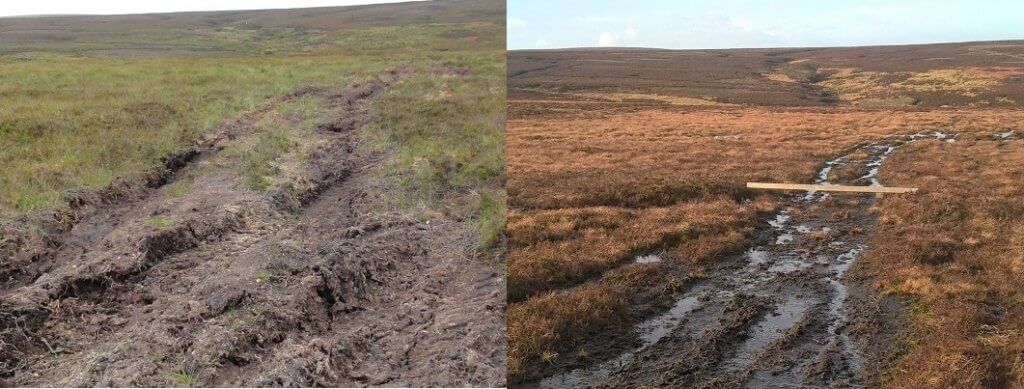
Of course, reseeding cotton grass and planting sphagnum plugs would speed things up, but you know who would end up paying for that – you and I. Where this route crosses a stream you can see that rainfall is washing the peat away and this gully will not recover without intervention. Remember there was no damage here at all in 2011 before the creation of the shooting butts. What’s the chance of the landowner dipping into his pocket to pay for the damage he’s caused – pretty slim I would say.
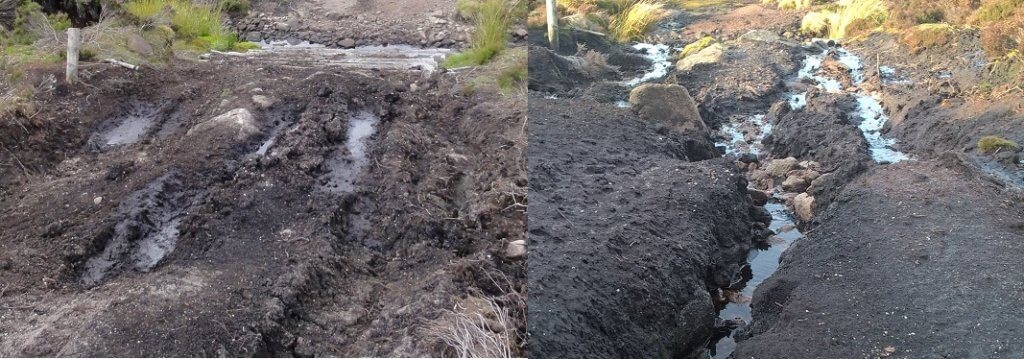
The grough re-profiling and gully blocking shown below is vital to the restoration of these moors and will benefit us all for years to come.
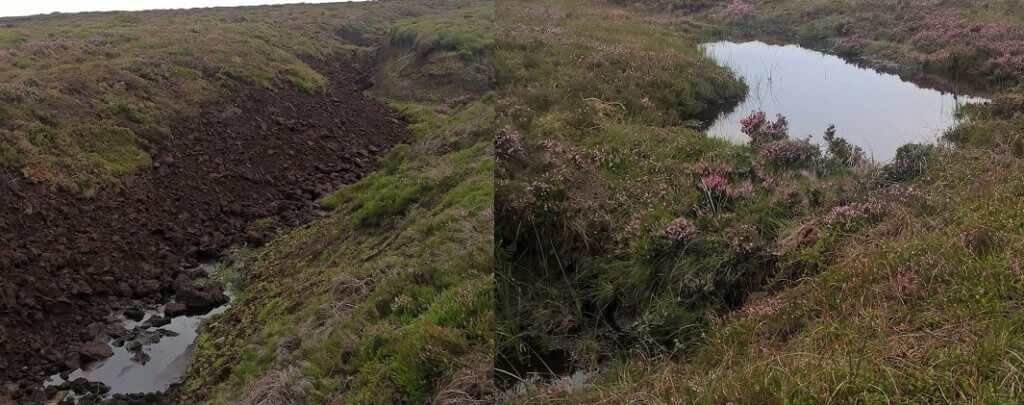
These projects often take place in remote areas which are difficult to access. But if you weigh the benefits shown above against the damage contractors vehicles have caused (shown below), the Public Goods account for this project will be running an overdraft for five years or more until the habitat recovers.
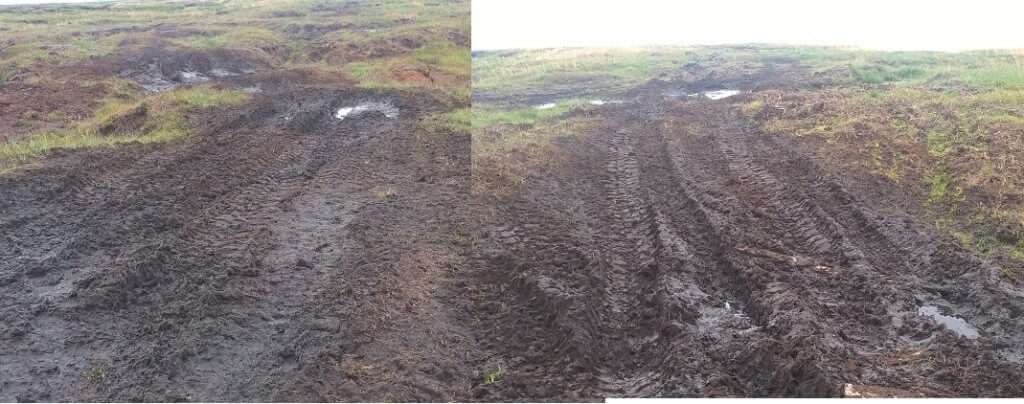
The common theme here (including the two roads featured in the last blog) is a complete lack of consultation. Apparently some in Natural England think that consulting the public, NGOs and even the National Park will result in projects that cost more and are slower to deliver. Did Natural England officers really think that no one would notice the turquoise plastic track at Midhope? The restoration project above also resulted in damage to a bridleway, the Highways Authority weren’t told either and of course they have legal powers to prevent damage to rights of way.
Difficult and lengthy restoration projects can work. The first stage of the Kinder project was to build a fence with the help of vehicles. This was achieved without habitat damage. Of course this project involved public consultation.
Huge sums of public money are spent on our uplands both through regular HLS payments of £56 per hectare and “capital” projects. There needs to be scrutiny and monitoring well beyond Natural England – this is our money can we really say it’s being spent wisely?
Mismanagement of uplands extends well beyond this corner of the Peak District. These photos of Brennand fell in Bowland show the reality of driven grouse shooting. The construction of this grouse butt demonstrates complete contempt for the conservation status of the land. And by the way last year in Bowland, Hen Harrier and Peregrine breeding crashed to zero.
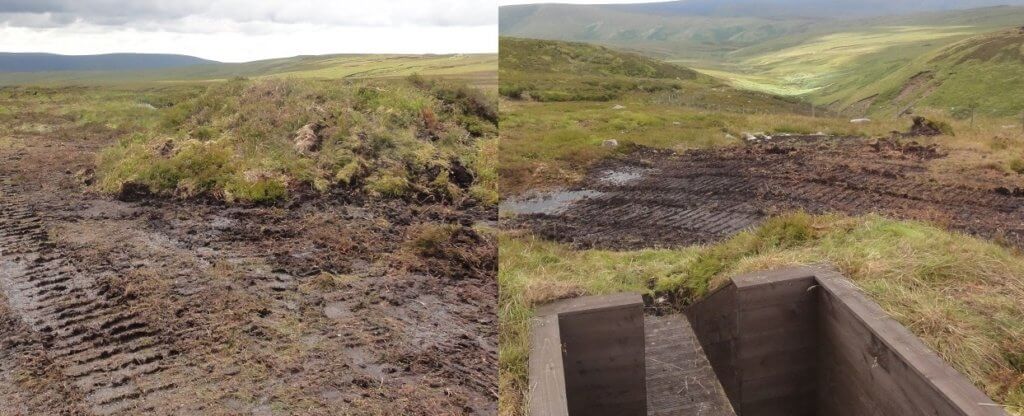
All great food for thought Bob. Brennand used to be very heavily over grazed by sheep in the eighties and early nineties and was the sore in the NWWA as it was then land holding in Bowland. These days the shooting is tenanted out to the Westminster estate who use it largely as a red legged partridge shoot. Needless to say it is some years since the Peregrines there , which have a very chequered history have even attempted to breed. We all know Bowland could and should be a wonderful area but scenically, ecologically and in terms of raptors it is much the poorer because of the shooting management.
Another loud blast from the Berzins gun.
Hopefully Therese Coffey and Co will have heard it loud and clear whilst skulking in their butts.
Food for thought indeed but more importantly the photographic evidence speaks volumes?
Public benefit for public funds, NOT private playgrounds, why anything else?
As for NE sadly, despite some good grassroots staff their senior management has demonstrated a failure to act in the public interest, so are they fit for purpose? Before you say be careful what you wish for, if there were no agency would we actually be any worse off? Government would lose its wall to hide behind as well as spin merchant for its various private interest associates? Radical review and reform?
Excellent blog, thanks.
Bob, powerful stuff.
Rock climbers are like mathematicians – incomprehensible. Fell runners are not much better. But here your evidence and arguments are crystal clear.
Thanks for your unpaid guardianship of this vast back yard. Keep chasing and belaying the blanket bog abusers.
Gamekeepers should be forced to either go on foot or only use horseback for transport. No ATVs at all. Still cause damage but much less so and it genuinely would help the traditional rural trades and crafts they pretend to care about.
Of course, we can’t afford it – and the economics of grouse shooting are obviously of overriding importance.
Well, if you believed either of those things Bob’s figures clarify the real situation: the public money that goes into grouse actually results in massively higher costs to society than either ‘traditional’ landuses can deliver in income, jobs etc. I’ve argued before that far from spending more we could probably save £1 billion per annum on water issues alone in England by efficient use of existing funds – it is what is known as ‘efficiency’ which has nothing whatsoever to do with the present Governments ‘austerity’ (ie cuts) which increasingly are costing more and more as gaps open up from healthcare to flooding.
Thanks Bob, it’s good to know what we are up against.
Spot on, Bob.
If Natural England aren’t willing to fully enforce restoration against those who damage these sensitive habitats in the course of running their businesses (and these moorland owners are probably laughing all the way to the bank and the gun shop), then we need more people like Bob to make it clear precisely what they’re getting away with on these SSSIs/Natura 2000 sites.
And to make up for it we need other parts of the Peak District moorlands which aren’t in private hands to be shooting free. Hence our petition to the National Trust. (Have you signed it yet?)
Grosue butts are small beer. I would like to see restoration enforced against those who damage habitats, birds, bats and people’s health by installing these things not just in Wild and Woolly places but Everywhere. There are now more than 7,300 of them onshore in our formerly Green and Pleasant. That Mad Frock Woman thinks they get put up by pixies using a great big dibber.
http://www.alexander-civil.co.uk/portfolio/glenconway-wind-farm-phase-1/